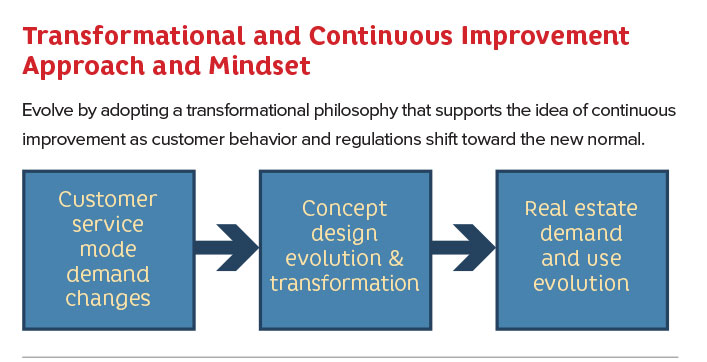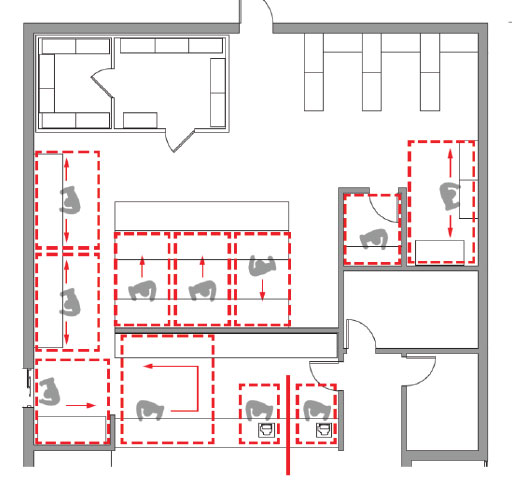All restaurants should regularly visualize what their store of the future (SOF) will look like. An exercise of this nature is important in the best of times. In light of the impact the coronavirus continues to have on this industry, it’s never been more important than it is today, especially with an ever-changing future.
 Juan Martinez, PhD, PE, FCSIAs we continue to assess the current pandemic’s impact, any upcoming SOF initiative will differ greatly from previous efforts. The thinking about the SOF will evolve based on three key factors: government and self-imposed mandates to keep consumers safe, guests changing their approach to how they use restaurants, and the overall corporate appetite for risk. Undoubtedly, each factor will continue to develop, but that should not stop restaurant leaders from giving their SOF initiatives serious thought.
Juan Martinez, PhD, PE, FCSIAs we continue to assess the current pandemic’s impact, any upcoming SOF initiative will differ greatly from previous efforts. The thinking about the SOF will evolve based on three key factors: government and self-imposed mandates to keep consumers safe, guests changing their approach to how they use restaurants, and the overall corporate appetite for risk. Undoubtedly, each factor will continue to develop, but that should not stop restaurant leaders from giving their SOF initiatives serious thought.
For example, in the future, will restaurants require greater segregation of production areas to serve different customer segments, such as those choosing to dine on-premises versus those dining off-premises? Prior to the pandemic, there was a growing trend among fast-casual and quick-service restaurants to add second make lines to better accommodate customers who order via apps or third-party delivery platforms. Will this become standard operating procedure? How will the need to socially distance employees impact back-of-the-house layouts? And how will these steps impact capital and operating costs?
One approach is to add more production areas and bigger kitchens to fulfill these demands, but doing so results in higher costs. The trick will be identifying ways to meet these new requirements while working from the same back-of-the-house space as before the growth in off-premises service. Start with a mentality that the back of the house should measure no more than one square foot and grow judiciously from there by right-sizing all the resources.
No Time to Test
It would seem restaurant executives will accept design and other changes more rapidly than other business leaders. Whereas before, there may have been a tendency to test new concepts or ideas until you are blue in the face — also known as analysis paralysis — the current crisis has taught company leaders that they can move a lot faster than previously thought to instill change. More important, though, restaurant leadership should understand no idea is too far afield for their business to consider.
For example, the experience inside the restaurant is what defined some brands prior to the pandemic. Now, these same brands have morphed into concepts that customers can use very successfully for off-premises dining. Some full-service restaurants are now driving more than 60% of their original sales with only off-premises options. This suggests their menu items can play a more prominent role in driving sales than was the case in the past. Joe’s Stone Crab has a Miami location that represents one fine-dining concept that’s done an excellent job with off-premises business. The service system for Joe’s takeout is extremely efficient and accurate. Whether guests order ahead or order takeout on-site, customer flow is fast.
Let’s not forget that executing off-premises orders means more productive sales since the labor cost is less due to guests typically ordering and paying for their food via an app or kiosk. Off-premises customers also don’t dirty the front-of-the-house spaces. Consider this a silver lining in the crisis.
Further underscoring the importance of off-premises customers for the foreseeable future is the fact that dining room density will be reduced in the near term to accommodate social distancing requirements. For example, restaurants in Texas reopened with the caveat of only being able to use 25% of dining room capacity. In Miami, restaurants opened at 50% capacity.
As a result, operators and designers will have to take great care in optimally sectioning off the front of the house to not only meet mandates and make customers feel safe but also to avoid compromising the remaining opportunity to make money. One concept is using shower curtains to divide the tables — talk about an inexpensive way to provide a customer-safe space. As this is done, managing customer wayfinding inside restaurants will become even more critical than normal. Consider dividers and other items to create spaces that feel special or intimate for guests.
To make up for lost capacity, operators will have to shift their focus to turning tables to drive more sales with less seating capacity in the short term. If a full-service operator can reduce the table use time from 60 to 45 minutes, the restaurant increases capacity by 25% while using the same number of tables. This can certainly offset the reduction in capacity. By designing the proper system, even less than 45 minutes of table use time is feasible.

Will Hand Sinks Be the New Centerpiece?
 Modular Back-of- the-House Workstations: Space considerations for back-of-the-house staff will likely come into play as operators adapt to social distancing guidelines.Bathrooms represent an area to make some simple yet impactful changes. Consider the benefits of automatic flush toilets and touchless handwashing — and even automatic door openers.
Modular Back-of- the-House Workstations: Space considerations for back-of-the-house staff will likely come into play as operators adapt to social distancing guidelines.Bathrooms represent an area to make some simple yet impactful changes. Consider the benefits of automatic flush toilets and touchless handwashing — and even automatic door openers.
It’s entirely possible that hand sinks will become more visible in the front of the house to illustrate the importance of cleanliness for both employees and patrons. There are concepts — Nando’s Peri Peri Chicken being one — that even before the pandemic incorporated hand sinks in prime spaces in the dining room.
Taking a longer-term view, fully touchless restrooms, which could include automatic sanitizing using UV lights, may have seemed farfetched before the pandemic, but may now be closer to reality.
Looking at self-serve ordering components, smartphones could possibly replace kiosk ordering and, for that matter, handheld menus, which would in turn eliminate yet another potential contamination spot as consumers would use their own personal devices.
Moving forward, the most important thing every member of the foodservice industry can do is embrace the opportunity to evolve, taking a continuous improvement approach to transforming their business into the future.



